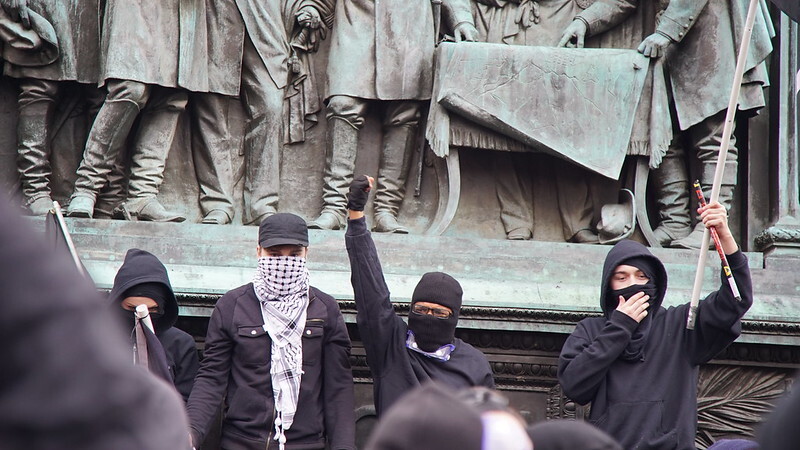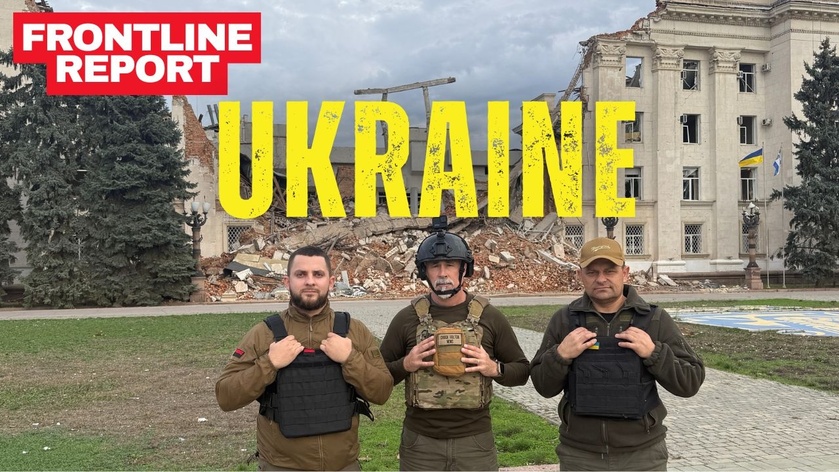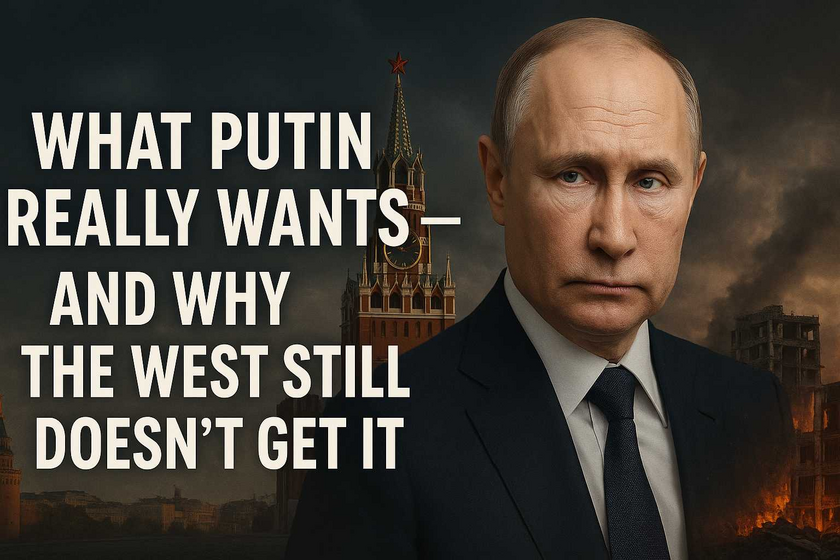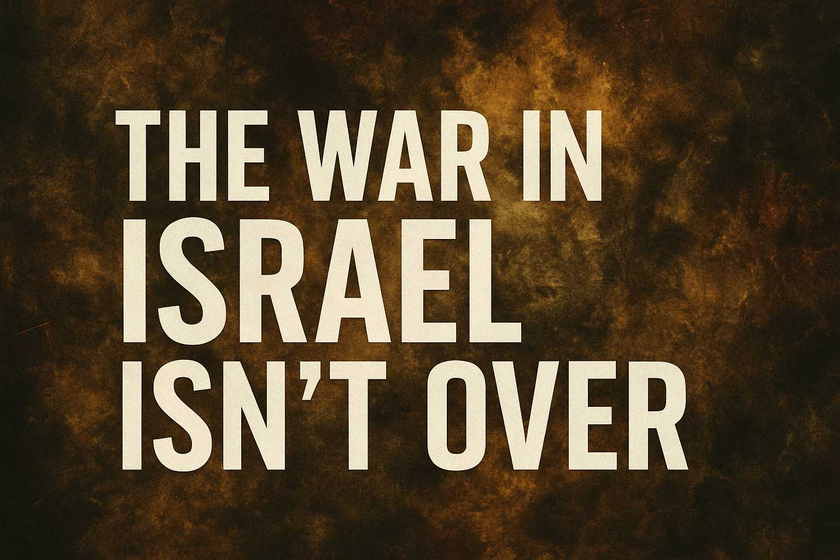I went to Ukraine to see if Ukraine is crumbling under the pressure from Russia or if they are holding their own. The people on the frontline suffer from drones attacking civilians and missiles striking every day, and the people want an end to the war that won't end with them under the rule of Russia. Because if that happens, the Ukrainians will be wiped out completely.

Some members have been asking for a written version of this:
The upcoming elections are stirring fears of potential unrest, with groups like ANTIFA preparing for action. What’s surprising to many is how these groups manage to profit from their arrests during protests. Below, I’ll outline the mechanics of how ANTIFA and other radical groups make money by being detained—and how it all ties back to your tax dollars.
1. Legal Observers: The ‘Eyes’ on the Ground
When protests escalate, you’ll often see people in green hats labeled ‘Legal Observer’ walking around. These individuals are part of the National Lawyers Guild (NLG), a progressive organization that claims to monitor for legal violations. However, they focus solely on documenting police actions, not the conduct of rioters. Their purpose? To provide footage and testimony that supports legal claims against law enforcement, setting the stage for lawsuits and compensation.
2. Strategic Arrests and Bail Protocols
Protesters often write a phone number on their arms—the hotline for the NLG. This group is prepared to bail out anyone arrested, ensuring that those detained don’t stay in jail for long. Once released, the charges are frequently dropped, especially in cities with sympathetic district attorneys. This lack of prosecution means that, while the protesters might have been arrested, their records remain clean.
3. The Lawsuit Strategy
Once charges are dismissed, the real profit-making begins. Protesters, with the help of NLG and other legal defense teams, file lawsuits against cities for unlawful arrest or excessive force. Citing police use of tear gas, rubber bullets, or other crowd control measures, they claim damages and seek settlements.
Cities have paid out substantial sums in response to these lawsuits:
Denver paid $1.6 million to seven individuals.
Austin, Texas disbursed $17.3 million.
Philadelphia compensated 343 protesters, totaling around $9.5 million.
These settlements, drawn from taxpayer funds, serve as a financial boon for the arrested individuals and the legal organizations involved. The lawyers’ fees are covered, and the remainder helps fuel future protests.
4. Recycling Bail Funds
Here’s where the process becomes even more lucrative. When someone posts bail—say, $2,500—and the case is later dropped, the bail money is returned to the individual who was arrested. However, this money was initially donated by organizations or activists—not paid by the protester. When it’s refunded, the protester pockets the cash, effectively receiving “pay” for getting arrested.
5. Funding Sources: A Network of Support
This entire cycle is sustained by grants and donations. Progressive groups like the National Lawyers Guild, Earth First, and others receive substantial funding:
Grants from the EPA for “environmental justice” initiatives can run into hundreds of thousands of dollars.
Nonprofits like the Sierra Club allocate funds to radical groups under the guise of environmental or social justice support.
Private donors and political figures contribute to bail funds. For example, Vice President Kamala Harris once promoted a bail fund that paid for protester releases.
6. The ‘Higher’ Purpose and Repercussions
Many rioters see this as a lucrative gig. Those who are jobless, underemployed, or ideologically driven don black clothing, mask up, and head to protests knowing there’s little risk and plenty of potential reward. They can spend a night throwing firecrackers, confronting police, and causing damage—all while knowing that sympathetic legal teams will cover their bail and potentially help them profit from it later.
This system not only fuels ongoing protests but ensures that rioters face minimal long-term consequences. With district attorneys in certain cities declining to prosecute and legal observers documenting police actions exclusively, the cycle continues unchecked.
Final Thoughts
This pattern is not hyperbole—it’s reality. I’ve seen it firsthand, spoken to those involved, and documented how the money flows. As we head into another election season, this model of monetizing protest arrests will likely intensify. Stay informed and be aware of how these mechanisms impact communities and taxpayers alike.

Netanyahu was once Israeli Finance Minister - and it shows. He understands a lot about economics, and is worth listening to in order to get a sense for where Israel's economy is headed.
BREAKING: The FBI and state of Utah have just released video of the Charlie Kirk kiIIer escaping from the scene following the shooting
He jumped off the rooftop, moved quickly through the parking lot, and then began walking casually to blend in before entering a wooded area.
He was wearing converse tennis shoes, a shirt with an eagle, and a baseball cap with a triangle.
I’ve had stem cell therapy through WholeLIFE’s Infinity Matrix, and it improved my eyesight. Since then, several members of my family have done the same. My son is planning to be scheduled for treatment soon to address chronic back issues.
WholeLIFE is a Christian non-profit that offers stem cell therapy at reasonable prices through clinics across the U.S. It’s a quick IV procedure that’s helping people recover from serious health problems.
If you’re even slightly curious, I recommend reaching out to Rebecca Tomlet. She’s a trusted family member and liaison for WholeLIFE and can answer your questions or get you scheduled for a free phone consultation.
Email: [email protected]
Here are some results from others who’ve gone through it:
Christina, 55, Oklahoma
"After losing 30 lbs of muscle and battling severe Lyme disease symptoms, stem cell therapy reactivated my muscles, restored my balance, cleared my brain fog, and at 5 months gave me my life back."
William, 84, Panama
...
This isn’t a mission trip or a news assignment. It’s a rare, small-group getaway with Chuck in one of the most beautiful and fascinating places on earth.
No packed schedule. No chaos. Just meaningful connection, time to recharge, and unforgettable experiences, from the Panama Canal to the peaceful mountains of El Valle.
Trip Highlights:
– One-on-one time with Chuck in a relaxed setting
– Top-tier accommodations in Panama City and El Valle
– Scenic hikes, local markets, beach day, and more
– Time to reflect, explore, and connect
This is a rare chance to go deeper, unplug from the noise, and spend quality time with like-minded people and with Chuck.
Details & signup: https://www.holtonnews.com/panama-tour/
Space is extremely limited — grab your spot now.

It's often those who seemingly don't do much, like the widow who gave the two pennies, who do great/significant things in God's eyes (Mark 12:41-44). On the Day of Judgment (2 Corinthians 5:10), the Lord will exalt some that no one honors among believers, but many esteemed of His people will be made light of by Him (Matthew 5:19). For God does not judge by appearance but righteously (John 7:24); and what man regards is an abomination in His sight (Luke 16:15)! It will be the humble and meek of God (Matthew 23:12), those who don't seek the praise of men, nor a grandeur platform and recognition, that will be rewarded and honored, in the presence of God the Father and His angels (1 Samuel 2:30, Luke 12:8). Those who are content with serving and loving Him from a pure heart, good conscience and sincere faith (1 Timothy 1:5), in whatever He asks of them (Colossians 3:23-24).


We’re all watching the same headlines, scrolling the same feeds, and trying to make sense of the same chaos. And yet, for all the information at our fingertips, there are still some very basic questions we aren't answering honestly — like what Vladimir Putin actually wants, why this war in Ukraine keeps grinding on, and what it really means for the United States and our allies.
If you missed the LIVE, you can watch it HERE
Do We Still Keep Our Promises?
Whenever I go live, I like to ask people where they’re watching from. It’s not just a gimmick; it tells me something important. There are folks in Poland, Germany, Israel, Armenia, and all over the United States who have skin in the game with what we’re about to talk about. They’re not watching this as an abstract discussion. For some of them, this is about whether the ground under their feet will still belong to their country five years from now.
So I asked a simple question: Should the United States keep the commitments it has already made to its allies?
I’m not talking about getting involved in every brushfire conflict on the planet. I’m talking specifically about the promises we have already put our name on — treaties we signed, obligations we accepted, and expectations we created that other nations have built their security around.
The biggest of those, of course, is NATO — the North Atlantic Treaty Organization — created after World War II for one core purpose: to keep a check on Russia. That wasn’t paranoia. That was historical memory. Russia, whether under the czars, the Soviets, or Putin, has an almost compulsive habit of invading its neighbors. In just the last few decades, they’ve gone into Georgia, Chechnya, Crimea, and now full-on into Ukraine. They’ve made no secret of the fact that they believe they have a right to dominate not only their immediate borderlands, but the wider European sphere as well.
The problem is that while Russia has been very clear about its ambitions, the West has not been nearly as clear about its resolve.
The War You Don’t See: Russia’s Cognitive Offensive
If you only look at maps and front-line reports, you might conclude that Russia is stumbling. Their advances are slow and costly, their equipment is getting older, and they’re losing a lot of men. But you miss half the story if you stop there, because the real battlefield — the one Putin is betting on — is not just in trenches and ruined towns. It’s in the minds of voters in the United States and Europe.
Russian intelligence and state-backed actors have poured millions of dollars into what’s now being called cognitive warfare. They’ve set up SIM farms, bot farms, and propaganda networks across multiple continents. These aren’t just a few trolls on a laptop. We’re talking about industrial-scale operations — huge racks of phones and servers churning out fake profiles by the hundreds of thousands, posing as Texans, Brits, Indians, Germans, and everything else you can imagine.
Their purpose is simple and very specific:
to quietly steer public opinion away from supporting Ukraine, to paint NATO as the real villain, and to soften the West’s will to resist Russian aggression. They don’t need most people to become full-on pro-Russian. They just need enough people to become skeptical, weary, and divided. They know that democracies often defeat themselves from the inside long before an enemy ever crosses the border.
Why Putin Keeps Showing Up to “Peace Talks” He Doesn’t Mean
You may have noticed something about every “peace process” floated over the last two years. Russia walks in, sits down at the table, plays the reasonable partner for a few days or weeks, and then undercuts the deal or simply ignores it.
There’s a reason for that.
Putin’s strategy is not to end the war quickly. His strategy is to drag it out as long as possible while shaping the political terrain in the West. As long as he can keep the guns firing, he believes he can:
Grind down Ukraine’s manpower and infrastructure
Burn through Western political patience
Deepen divisions between Europe and the United States
Wait for elections or leadership changes to give him a more favorable climate

From where I sit, the war in Israel is nowhere near over. It has simply changed shape. What started as a shock on October 7th has become a long, grinding contest across multiple fronts, and while the headlines may have grown tired, the stakes haven’t shrunk at all.
To understand what’s coming, you have to see the whole board, not just the one square called Gaza.
Five Fronts, One War
Israel is not dealing with a single isolated conflict. It is facing at least five interconnected fronts, each of them fragile and potentially explosive:
Gaza
Judea and Samaria (what the world insists on calling the West Bank)
Lebanon
Syria
Iran and its proxy network
They overlap, feed into one another, and are all being influenced—directly or indirectly—by Tehran. When people talk about a “ceasefire,” they’re usually talking about Gaza. But if you zoom out, you’ll notice there has never really been a ceasefire at all.
Gaza: A “Ceasefire” in Name Only
Let’s start with Gaza, because that’s where most cameras still point, at least when they bother to look.
On paper, there’s been a ceasefire. On the ground, Hamas has been shooting at Israeli troops almost every day. There have been firefights, mortars, IED attacks, and at least a few IDF soldiers killed since that so-called pause went into effect.
The Israelis have divided the Strip into zones: a red zone where Hamas still controls the ground, and a green zone under IDF control. You’d think the green zone would be relatively stable, but in reality Hamas fighters keep emerging from tunnel shafts inside those areas and ambushing Israeli patrols. More than forty of those fighters have been killed in these incidents alone.
So if you’re picturing neat front lines and a quiet truce, erase that image. Gaza is still a warzone, it’s just a slower, dirtier, more subterranean version of the earlier stages.
The map we’re looking at right now will probably define Gaza for the foreseeable future. Israel is unlikely to pull completely out of the green zone anytime soon. If it did, there are at least nine local militias in that territory—tribal groups that hate Hamas—who would instantly start fighting for control. You’d see a civil war inside a war.
On top of that, Hamas still holds weapons, still has command structures, and still has fighters who believe, very sincerely, that Israel has no right to exist. That’s why Israel’s second war aim—after bringing the hostages home—was to dismantle Hamas as a fighting force. They have not finished that job, and they know it.
The Hostages and the Narrative of “Israel is Losing”
A lot of pundits you see online—especially people like Douglas Macgregor, Scott Ritter, and some of the usual talking heads—keep repeating the line that “Israel has lost this war” and is collapsing from within.
That claim doesn’t hold up.
Israel has managed to secure the return of every single hostage except one. When this war began, I honestly didn’t think that was possible. The chaos in Gaza, the tunnel networks, the sheer brutality of Hamas made it seem almost inevitable that many captives would simply disappear—killed, buried, or used as human shields until the end.
Yet here we are: one hostage still unaccounted for, and even his remains may soon be recovered. That is an extraordinary outcome by any military or intelligence standard, and it is a victory no matter what the doom-mongers say.
At the same time, Israel has been quietly preparing for the next phase. Their defensive capabilities are actually stronger now than they were on October 6th. The Iron Beam laser defense system—something the United States and Russia both struggled to make operational—is finally being fielded. It’s not science fiction anymore; it’s an actual working layer in their air-defense umbrella. That’s going to matter a lot if this war expands into a full regional conflict.
So no, Israel is not crumbling. It is bruised, deeply divided internally in some ways, but militarily more ready than at any time since the fighting began.












